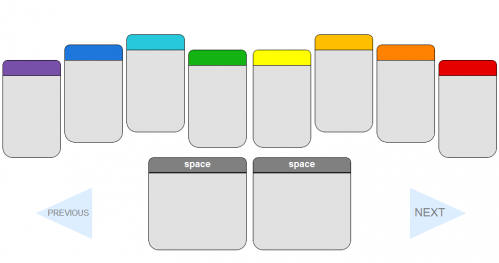November 8, 2012 report
ASETNIOP may hit the right chords for tablet text (w/ Video)

(Phys.org)—When you find the perfect solution to writing on a tablet you want to let the world know. Numerous reviews of new gadgets attempt to ease the frustration of writers struggling with seven hundred words to be composed on a tablet keyboard. To date, there are keyboard peripherals that one can buy that have received favorable ratings, but the question remains—with all the gee-whiz visuals and entertaining apps developed for tablets, can someone please figure out better answers than cramped, or overpriced, keyboards or just systems that nicely accommodate writing input, including all the cutting, pasting, deleting, word replacing, and paragraph-shifting, no matter what the form factor. Enter ASETNIOP, which aims to get to first place as the best way to write using a tablet.
A number of reviews of ASETNIOP have found it interesting; one blogger has said it is simply brilliant. ASETNIOP is self-defined as a chorded keyboard replacement method.
It is designed to allow you to touch-type on tablet computers without reliance on Qwerty's single-key approach with its ASDF on the left and JKL on the right. Instead, think "chord" rather than single note.
ASETNIOP uses a single finger for some keys and two or more fingers pressed at the same time for others as well as for punctuation characters, numbers, symbols and various other function keys.
There is no separate keyboard device; the entire touchscreen is the keyboard. The ASETNIOP site says that the method carries advanced features like the use of stenographic combinations as shortcuts to produce common words, automatic correction of common input errors, and the ability to activate word prediction features.
With ASETNIOP, there are primary keys for the single finger and there are paired keys including those assigned to produce commonly used punctuation marks. The thumbs are used as a shift key and a space bar.
ASETNIOP is being promoted as encouraging a mode of input where the user only needs to concentrate on the action of pressing a specific finger down; just where the finger is making contact becomes irrelevant. That is an attractive proposition when one thinks of how eyes need to shift back and forth from screen to board to make sure the fingers are typing the right characters. According to ASETNIOP, "The basic question that drives the process for existing keyboards and keyboard replacement methods is 'where is a finger being pressed down?' With ASETNIOP, this question is changed to 'which finger is being pressed down?'"Other advantages being promoted include space-saving and that, once familiar with which keys go with which letters, one can type with the same speed as one would on a Qwerty keyboard.
ASETNIOP, as the site points out, is not the first chorded approach; there have been others but ASETNIOP is said to be a cut above. "Chorded keyboard methods have been around for quite some time. Unfortunately, all of these suffered from major design or functional flaws. Some were limited to very low input speeds. Some consisted of alphabets and shortcuts that were unreasonably hard to learn. And some were just prone to far too many errors, leading to an incredibly frustrating experience," according to the site.
This writer, however, did not find the tutorial easy to follow. Do you want to delete a letter or entire word that is spelled correctly, but you still want to delete it? Good luck. There was mention of a backspace key, which may or may not be designed to delete. The tutorial said, "The first new key you'll learn is the backspace key. It's one of the first things you learn, because when you're getting started, you'll be using it as it!" After many attempts, trying to understand how to operate the pinky and other finger involved for using the backspace key was not possible for this writer.
For those who are lucky enough to be able to follow the instructions, success is in the works to move beyond two-finger exercises to using chords of three or more fingers to generate entire words. Shortcuts can be used to produce frequently used words such as "and," "be," "of," "that," and others.
More information: asetniop.com/
© 2012 Phys.org



















